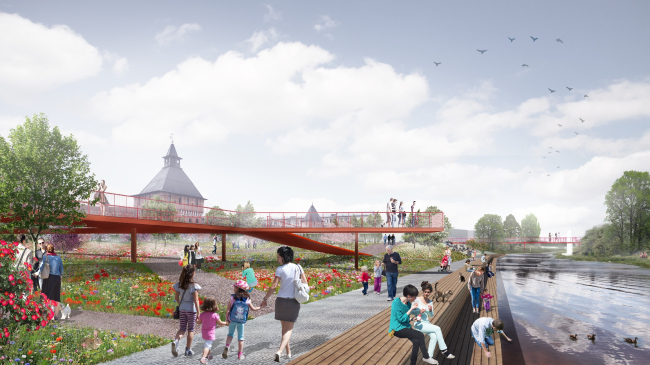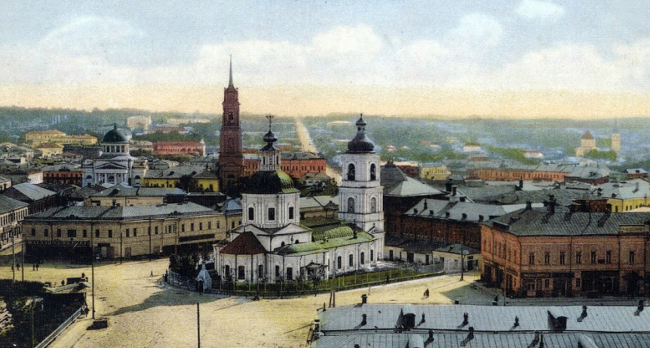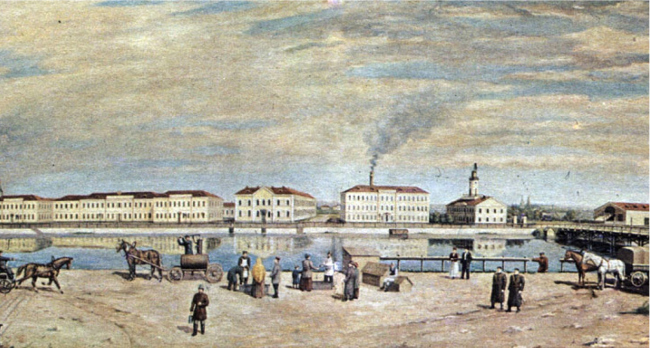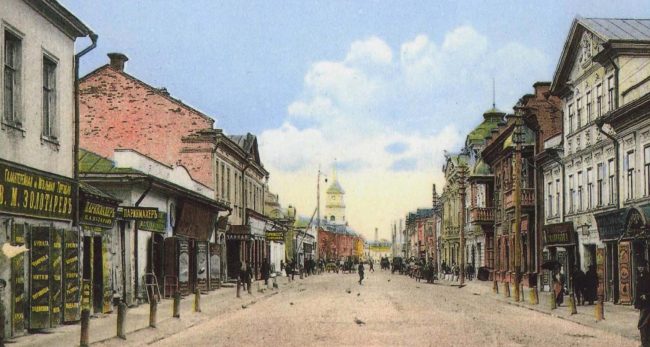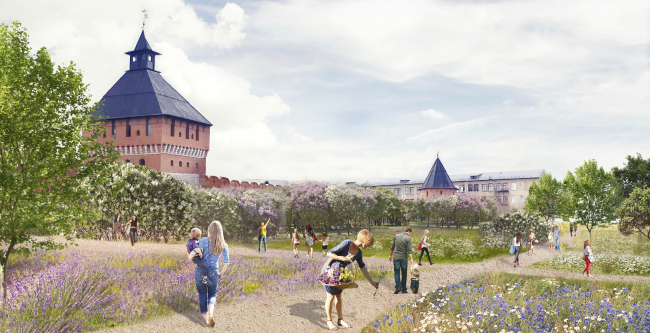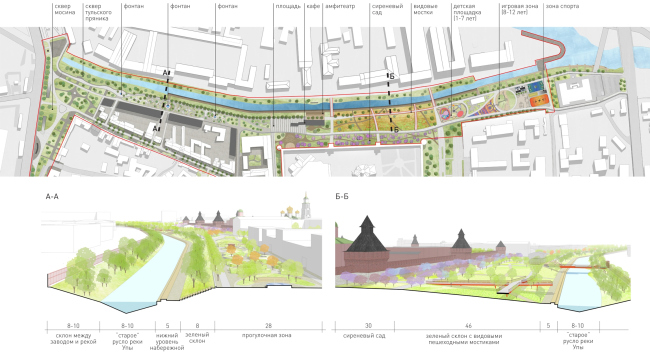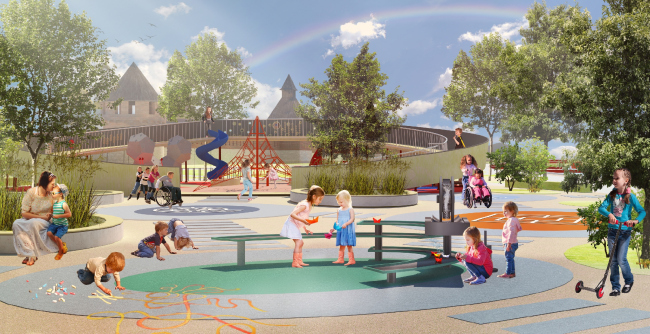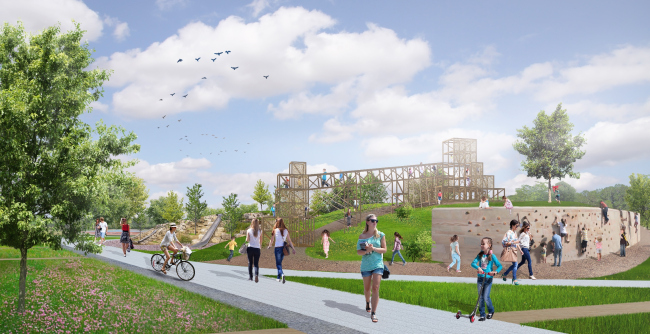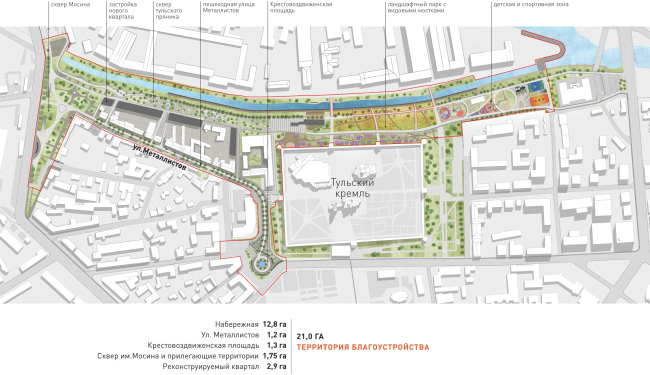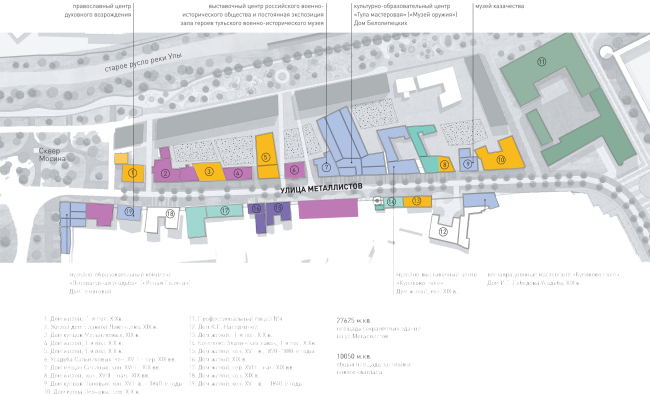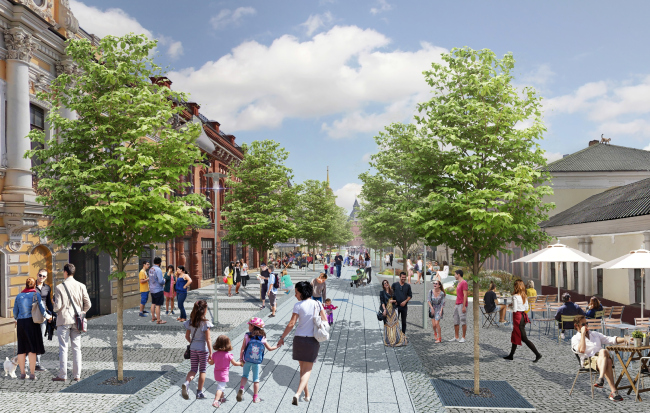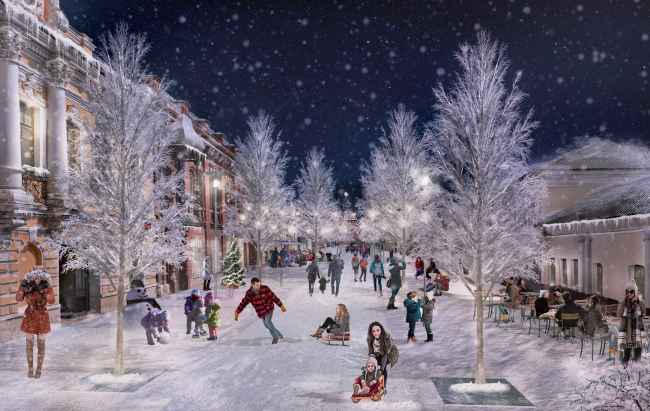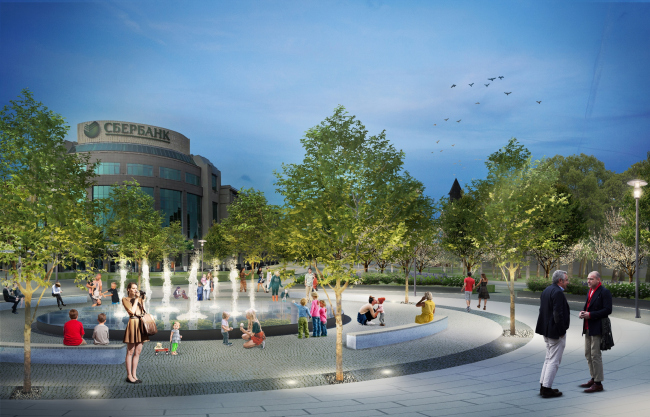|
Published on Archi.ru (https://archi.ru) |
|
| 11.09.2017 | |
|
Re-cultivation of the City Center |
|
|
Alla Pavlikova, Julia Tarabarina |
|
| Architect: | |
| Dmitry Likin | |
| Oleg Shapiro | |
| Studio: | |
| WOWHAUS | |
|
The project of reorganizing the embankment in the center of Tula helps the city to recover the hundred-year-old complex that has been revised with regard to the principles of modern urban planning. The project of renovating the Tula embankment © WOWHAUSNorth of the Tula Kremlin, there is an island that looks very much like Moscow’s Sadovniki, only slightly smaller: a little over a kilometer long. It was upon this island that the first Tula’s fortress was founded, which is proven by the old maps. Ivan III carried it over to the left bank of the Upa River, i.e. to the mainland, and Basil III rebuilt it in brick; currently, this is the city’s main heritage site. 200 years after the island was “vacated”, Peter the Great founded the Royal Small Arms Factory here, which has been successfully operating ever since. In the XX century, its buildings occupied the whole island, and the factory annexed the Kazanskaya Embankment – the left bank of the Upa River next to the Kremlin. The boundary of the plant locked on with the wall of the Kremlin – arguably, this is the closest vicinity ever of a medieval fortress and an industrial park. The Tula Small Arms Factory gave up to the city 12 hectares of its land but the project provides for the riverbed of the Upa as well. It was planned that the riverbed would be cleaned, deepened and filled with water, thus turning into a channel about 10 meters wide with an adjustable intake of water. The strip of land that for decades accumulated the industrial waste was to be re-cultivated and turned into a recreational area. All of this must make a positive difference to the ecology of the city center. Krestovozdvizhenskaya Square. Archive materials / provided by WOWHAUSThe Kazanskaya Embankment. View of the Kremlin from the Small Arms Factory. Archive materials / provided by WOWHAUSThe Embankment. View of Small Arms Factory from the Kremlin. Archive materials / provided by WOWHAUSThe Kremlin wall steps away from the river the furthest at this point – 46 meters; in front of it, the architects were able to find a place for a cherry garden and other perennial plants that blossom all through the summer, as well as a series of little sightseeing bridges with deep cantilevers of sightseeing platforms resting on supports on the slope of the bank – the architects also included into their network two already-existing pedestrian bridges over the river. Left of the lilac garden, two small factory buildings will be preserved: they will mark the city square, and it will be possible to make shops and restaurants in them. Behind the mini-square, at the joint with the Kremlin wall, and next to the Myasnitskaya tower, the architects are planning to make an open-air concert stage, while the slope of the bank will get an open-air amphitheater. To the east, in the direction of the Proletarsky Bridge, there are two playgrounds designed for children of two different age brackets, and a sports field – the latter was designed with the consulting input from the local sports communities – it includes bicycle tracks, jogging tracks, and a skate park. The architects also designed a bicycle track running alongside the embankment and proposed to extend it, wherever possible, to other streets of Tula’s downtown area. It must be said that generally the architects worked on the whole project based on the participation principle: they also consulted the local business community, students of local lore and local preservation activists: based on the accumulated data, the would constantly fine-tuned their project. The Pyatnitskaya Street. Currently - the Metallistov Street. Archive materials / provided by WOWHAUSThe project of renovating the Tula embankment. The lilac garden © WOWHAUSThe project of renovating the Tula embankment © WOWHAUSFrom the opposite side, i.e. from the Kremlin to the Zarechensky Bridge, stretches a boulevard with three fountains. The curls of the boskets are meant to divide its territory into private zones. Closer to the Spassky streets, a fragment of the embankment grows into a “Park of Tula Honey-Cake”, while the existing park with a monument to the inventor of the three eighths of an inch caliber rifle, Sergey Mosin, is enlarged and additionally landscaped. There are also plans for opening the Kremlin’s riverside gate, which had stood shut for almost a century. Possibly, the city will be able to use the false river as a big skating rink in the wintertime. But then again, a filled-out skating rink with a new year tree is also made on the main city square at the Kremlin wall. The river and its embankment are two important parts of the concept but they are not the only ones: the architects’ scope of attention also covered the Metallistov Street, the former Pyatnitskaya, stretching parallel to the river in the west part of the city center. Currently, this street is essentially a part of the drive-thru before the Kremlin from the Mosina Street to the Mendeleevskaya Street. Wowhaus proposed to plant the Metallistov Street with trees and turn it into a pedestrian promenade. It is planned that all the monuments will be restored, a few public buildings will be built in the depth of the city blocks to replace old dilapidated buildings, one of the new buildings being a theater. The yards will be open for end-to-end passage, which will provide an extra connection to the embankment. The project of renovating the Tula embankment © WOWHAUSThe sports area. The project of renovating the Tula embankment © WOWHAUSThe playground for children under 7 years old. The project of renovating the Tula embankment © WOWHAUSApart from the habitual set of the public life, the region administration and the Ministry of Culture of the Russian Federation also have plans for turning the Metallistov Street into a “museum quarter” – by placing a whole string of museums in the historical buildings: a museum of Tula weaponry, a museum of Tula Honey-Cake, a Cossacks museum, an expo hall of ÐÂÈÎ, as week as affiliate branches of Yasnaya Polyana, Kulikovo Field, and Polenovo. It is planned that the yards will become a venue for lectures, concerts and exhibitions. Some of the mansions, however, will be remodeled to become hotels and educational institutions. The ground floors will be occupied by shops and cafés with summer terraces – this neighborhood must become, on the one hand, a cultural center, and, on the other hand, an example and a driver for the development of the postindustrial economy of the city, a place for the concentrated eye walking. The playground for children over 8 years old. The project of renovating the Tula embankment © WOWHAUSThe project of renovating the Tula embankment. The landscaping plan © WOWHAUSThe project of renovating the Tula embankment. Transforming the museum quarter © WOWHAUSThe round Krestovozdvizhenskaya Square at the corner of the Kremlin will also partly become pedestrian-only – a sort of “finale” of the walking route. It will get new trees, paving, and a small fountain. In addition, the Kremlin entrance, which is there on the square, will be made more convenient. The driveway before the south wall of the Kremlin, however, will be kept intact. According to Oleg Shapiro, the transport experts are sure that if the Metallistov Street becomes pedestrian-only, the city traffic will not suffer, the automobile streams being switched to alternative routes. Besides, it is planned that after a new bridge over the Ula is launched in 2019, the city center’s transport load will be relieved. On the other hand, the new pedestrian route will dramatically change the city center turning it into a cohesive transparent space and one of the main event hubs of the city. The project of renovating the Tula embankment. The metallistov Street © WOWHAUSThe project of renovating the Tula embankment. The metallistov Street © WOWHAUSThe project of renovating the Tula embankment. The Krestovozdvizhenskaya Square © WOWHAUS |
|
